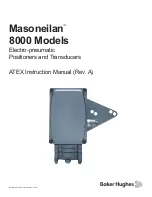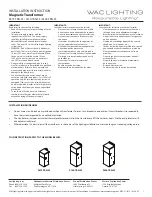
100
MODEL 5081-A
SECTION 15.0
TROUBLESHOOTING
15.2.4 OuEr rAngE, In Curr HI, and In Curr LO
the first two messages imply that the amperometric sensor current is very high (greater than 210 µA) or the sensor cur-
rent has a very large negative number. Normally, excessive current or negative current implies that the amperometric sen-
sor is miswired or has failed. occasionally, these messages may appear when a new sensor is first placed in service.
1. Verify that wiring is correct and connections are tight. Be sure to check connections at the junction box if one is being
used. Pay particular attention the anode and cathode connections.
2. Verify that the transmitter is configured for the correct measurement. See Section 7.4. Configuring the measurements
sets (among other things) the polarizing voltage. Applying the wrong polarizing voltage to the sensor can cause a large
negative current.
3. If the sensor was just placed in service, put the sensor in the zero solution and observe the sensor current. It should
be moving fairly quickly toward zero. to view the sensor current go to the main display and press
ê
until
Input Current
appears. Note the units: nA is nanoamps, µA is microamps.
4. Replace the sensor membrane and electrolyte solution and clean the cathode if necessary. See the sensor instruction
sheet for details.
5. Replace the sensor.
15.2.5 nEED 0 CAL
Need Zero Cal means the measured concentration is a large negative number. the transmitter subtracts the zero current
from the measured current before converting the result to a concentration reading. If the zero current is much greater than
the measured current, the concentration reading will be negative.
1. Check the zero current and the present sensor current. to view the zero current, go to the main display and press
ê
until
zero Current
appears. the value shown is the zero current the last time the sensor was zeroed. to view the pres-
ent sensor current, go to the main display and press
ê
until
Input Current
appears. Note the units: nA is nanoamps,
µA is microamps.
2. Refer to the appropriate section for calibrating the sensor. Place the sensor in the zero solution. Verify that the sensor
reading is within or at least very close to the zero current limits. It may take as long as overnight for the sensor to reach
a stable zero current.
15.2.6 PH In HI
pH In means the voltage from the pH measuring cell is too large.
1. Verify all wiring connections, including connections in a junction box.
2. Check that the pH sensor is completely submerged in the process liquid.
3. Check the pH sensor for cleanliness. If the sensor looks fouled or dirty, clean it. Refer to the sensor instruction manu-
al for cleaning procedures.
4. Replace the sensor.
15.2.7 No SOLngnd
In the transmitter, the solution ground (Soln GNd) terminal is connected to instrument common. Normally, unless the pH
sensor has a solution ground, the reference terminal must be jumpered to the solution ground terminal.
HOWEvER, WHEN
THE pH SENSOR IS USED WITH A FREE CHLORINE SENSOR THIS CONNECTION IS NEvER MADE.
















































